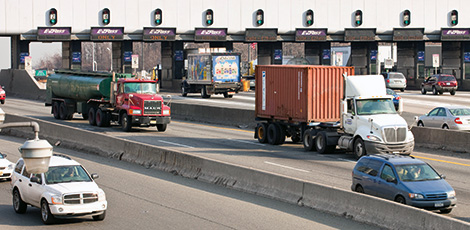
Organizing for Operations
Organizing for operations involves making transportation systems management and operations (TSMO) a central part of an agency’s mission and institutional structure. This is accomplished by advancing TSMO programs and projects within the agency. A specific guidance framework has been developed to help transportation agencies improve the effectiveness of their TSMO activities. The framework, the "Operations Capability Improvement Process," is based on self-evaluation regarding the key process and institutional capabilities required from a transportation agency (or group of agencies) to achieve effective TSMO.
This framework is adapted from a concept developed in the information technology (IT) industry called the "Capability Maturity Model," which has been tailored to the transportation community. It is based on self-evaluation regarding the key process and institutional capabilities required from a transportation agency (or group of agencies) to achieve effective TSMO. The Operations Capability Improvement Process identifies six critical dimensions of process and institutional capability that directly relate to improving TSMO program effectiveness: business processes (e.g., planning, budgeting); standardization/documentation of systems and technology; utilization of performance measures; cultural understanding, acceptance, and championship of TSMO relevance; organizational structure and staff development; and effective external collaboration and partnerships.
OTHER RESOURCES
- Advancing TSMO Through Organizational Structures
- Applying TSMO to Rural Areas
- Organizing for TSMO – 2020 Peer Exchange Report
- Advancing Organizational Capabilities for Transportation Systems Management and Operations: February 2018 Peer Exchange Report
- Advancing TSMO: Making the Business Case for Institutional, Organizational, and Procedural Changes
- Capability Maturity Frameworks for TSMO
- Connecting TSMO with Other Disciplines
- Creating an Effective Program to Advance Transportation System Management and Operations: Primer (Capability Maturity Model)
- Developing and Sustaining a Transportation Systems Management & Operations Mission for Your Organization: A Primer for Program Planning
- Does Travel Time Reliability Matter?
- E-tool for Business Processes to Improve Travel Time Reliability
- Organizing for Reliability – Capability Maturity Model Assessment and Implementation Plans Executive Summary
- Guidelines for Applying the Capability Maturity Model Analysis to Connected and Automated Vehicle Deployment
- Improving Business Processes for More Effective Transportation Systems Management and Operations
- Improving Transportation Systems Management and Operations – Capability Maturity Model Workshop White Papers
- Business Processes (White Paper, Webinar)
- Systems and Technology (White Paper, Webinar)
- Performance Measurement (White Paper, Webinar Slides)
- Culture (White Paper, Webinar Slides)
- Organization and Staffing (White Paper, Webinar)
- Collaboration (White Paper, Webinar)
- Integrating Business Processes to Improve Transportation System Performance: Advancing Planning for Operations Technical Brief
- Organizing for Operations Case Studies
- Organizing for TSMO - Case Study 1: Business Processes – Optimizing Existing Planning and Implementation Processes with TSMO (HTML, PDF 831KB)
- Organizing for TSMO - Case Study 2: Systems and Technology – Utilizing ITS Architecture to Advance TSMO (HTML, PDF 1.2MB)
- Organizing for TSMO - Case Study 3: Performance Measurement – Making Data-driven Transportation Decisions Using Performance Measure (HTML, PDF 1.1MB)
- Organizing for TSMO - Case Study 4: Culture - Changing the Culture Towards TSMO in State Departments of Transportation (HTML, PDF 1.9MB)
- Organizing for TSMO - Case Study 5: Organization and Staffing - Organizing for TSMO (HTML, PDF 977KB)
- Organizing for TSMO - Case Study 6: Collaboration - Partnering for Traffic Incident Management (HTML, PDF 887 KB)
- Organizing for TSMO - Case Study 7: Integrating the Capability Maturity Model into Agency Processes (HTML, PDF 539 KB)
- Organizing for TSMO - Case Study 8: Training for TSMO (HTML, PDF 685 KB)
- Organizing for TSMO - Case Study 9: State Department of Transportation Examples 1 of 2 (HTML, PDF 1.1 MB)
- Organizing for TSMO - Case Study 10: State Department of Transportation Examples 2 of 2 (HTML, PDF 1.1 MB)
- Organizing for TSMO - Case Study 11: Metropolitan Planning Organization Examples (HTML, PDF 608 KB)
- Organizing for TSMO - Case Study 12: Border Crossings (HTML, PDF 2.2 MB)
- AASHTO Transportation Systems Management and Operations Guidance
- SHRP 2 Report S2-L06-RR-1: Institutional Architectures to Improve Systems Operations and Management
- SHRP 2 Report S2-L06-RR-2: Guide to Improving Capability for Systems Operations and Management
- SHRP 2 Report S2-L01-RR-1: Integrating Business Processes to Improve Travel Time Reliability
- SHRP 2 Report S2-L01-RR-2: Guide to Integrating Business Processes to Improve Travel Time Reliability
- SHRP2 Solutions Regional Operations in the 21st Century – A Vital Role for MPOs
- SHRP2 Operations in the 21st Century DOT – Meeting Customers Needs and Expectations
Webinars
- Achieving Better Coordination Between TSMO and Information Technology: Part 1
- Achieving Better Coordination Between TSMO and Information Technology: Part 2
- Organizing for Transportation Systems Management & Operations (TSMO) Executives' Panel – Part-1
- Organizing for Transportation Systems Management & Operations (TSMO) Champions' Panel – Part-2
- Transportation Systems Management & Operations (TSMO)…. What Does it Mean to Planners?
- Transportation Systems Management & Operations (TSMO) Program Plan Roundtable – 2016
- Transportation System Management & Operations (TSMO) Program Plan Development Roundtable – 2017

